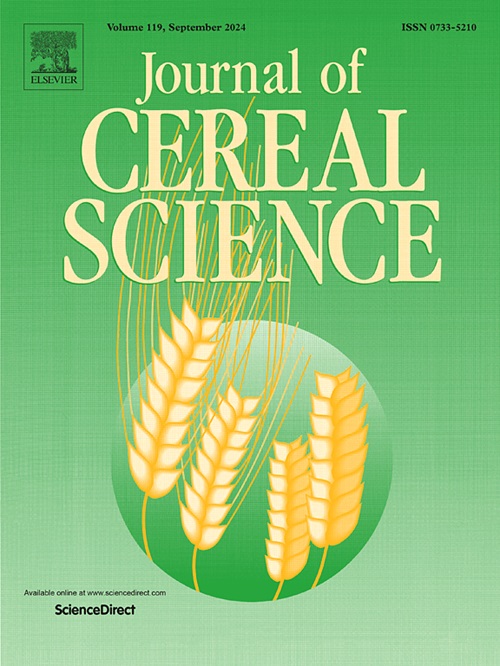Understanding the mechanism of alkali-soluble glutenin addition on inhibition of wheat amylose retrogradation
IF 3.9
2区 农林科学
Q2 FOOD SCIENCE & TECHNOLOGY
引用次数: 0
Abstract
The retrogradation of wheat amylose during refrigeration results in a hardness enhancement of wheat-based products. It has been found that glutenin serves as an effective additive for retarding retrogradation. The objective of this study was to elucidate the mechanisms by which alkali-soluble glutenin (ASG) hindered wheat amylose retrogradation using a range of techniques, including IR, 13C Solid-state NMR, X-ray diffraction, DSC and retrogradation kinetics. The results demonstrated a notable decline in the retrogradation rate of wheat amylose, from 74.26 % to 40.13 % when blended with 12.5 % ASG at 30 °C for 90 min. The ASG exhibited an intermolecular to intramolecular β-sheet ratio of approximately 2:1, accompanied by a considerable number of disulfide bonds in the complex. Infrared spectroscopy revealed that dehydration condensation occurred between the Arg Cε of ASG and C1 of wheat amylose, while hydrogen bonds were formed between the proline amino group in ASG and C4 of wheat amylose. These interactions led to a significant reduction in the diffraction peak intensity at 2θ ∼22.3° of the complex, offering valuable insights into the mechanism by which ASG inhibited wheat amylose retrogradation. Furthermore, a notable decrease in the retrogradation kinetic index (k and n) was evident. These findings establish a theoretical foundation for the development of technologies aimed at inhibiting the short-term retrogradation of flour-based products.
探讨添加碱溶性谷蛋白抑制小麦直链淀粉退化的机理
小麦直链淀粉在冷藏过程中的退化导致小麦基产品的硬度增强。研究发现,麸质蛋白是一种有效的缓退添加剂。本研究的目的是通过一系列技术,包括IR, 13C固体核磁共振,x射线衍射,DSC和退化动力学,阐明碱溶性谷蛋白(ASG)阻碍小麦直链淀粉退化的机制。结果表明,小麦直链淀粉与12.5%的ASG在30°C下反应90 min后,其降解率从74.26%下降到40.13%。ASG的分子间和分子内β-片比约为2:1,并伴有相当数量的二硫键。红外光谱分析表明,ASG的Arg Cε与小麦直链淀粉的C1之间发生脱水缩合,而ASG的脯氨酸氨基与小麦直链淀粉的C4之间形成氢键。这些相互作用导致复合物在2θ ~ 22.3°处的衍射峰强度显著降低,为ASG抑制小麦直链淀粉退化的机制提供了有价值的见解。此外,退化动力学指数(k和n)明显降低。这些发现为开发旨在抑制面粉制品短期退化的技术奠定了理论基础。
本文章由计算机程序翻译,如有差异,请以英文原文为准。
求助全文
约1分钟内获得全文
求助全文
来源期刊

Journal of Cereal Science
工程技术-食品科技
CiteScore
7.80
自引率
2.60%
发文量
163
审稿时长
38 days
期刊介绍:
The Journal of Cereal Science was established in 1983 to provide an International forum for the publication of original research papers of high standing covering all aspects of cereal science related to the functional and nutritional quality of cereal grains (true cereals - members of the Poaceae family and starchy pseudocereals - members of the Amaranthaceae, Chenopodiaceae and Polygonaceae families) and their products, in relation to the cereals used. The journal also publishes concise and critical review articles appraising the status and future directions of specific areas of cereal science and short communications that present news of important advances in research. The journal aims at topicality and at providing comprehensive coverage of progress in the field.
 求助内容:
求助内容: 应助结果提醒方式:
应助结果提醒方式:


